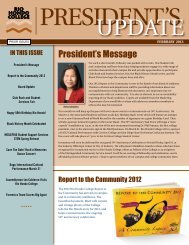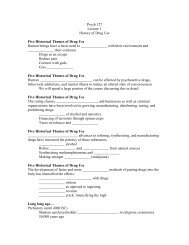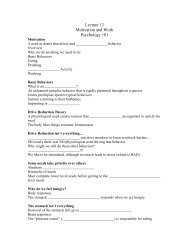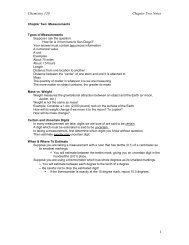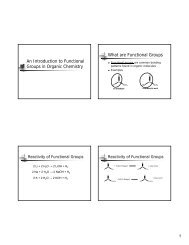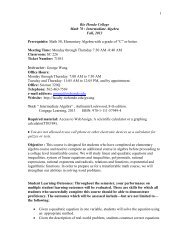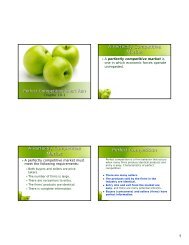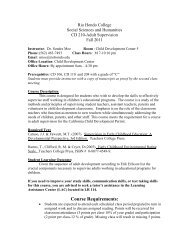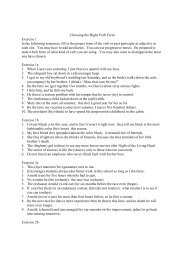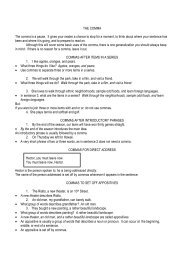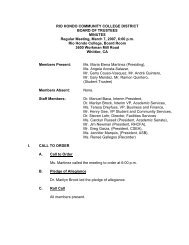Complete College Catalog 2011-2012 - Rio Hondo College
Complete College Catalog 2011-2012 - Rio Hondo College
Complete College Catalog 2011-2012 - Rio Hondo College
You also want an ePaper? Increase the reach of your titles
YUMPU automatically turns print PDFs into web optimized ePapers that Google loves.
Positioning Systems GPS, develop<br />
GIS data, explore solutions to real<br />
problems and produce supportive<br />
documentation in a variety of formats<br />
including constructing web pages and<br />
plotting maps.<br />
3 Units<br />
36 Lecture hours<br />
54 Lab hours<br />
GIS 220<br />
Intermediate Geographic Information<br />
Systems<br />
Prerequisite: GIS 120 or basic level<br />
competency in ArcView<br />
Transfers to: UC (credit limit*), CSU<br />
(*Students will receive credit from UC<br />
for only one of the following courses:<br />
GIS 120 or GIS 220)<br />
This intermediate course provides<br />
further study in ArcView and<br />
an introduction to its extensions<br />
which apply to discipline-specific<br />
applications using a Geographic<br />
Information System (GIS). Course<br />
work is based on the mapping and<br />
spatial analysis capabilities of ArcView<br />
and other GIS related software,<br />
introduction to Global Positioning<br />
Systems (GPS) terminology,<br />
technology, data structures, use of<br />
metadata and hands on training using<br />
GPS remote sensing hardware and<br />
software. This course may be taken<br />
once for credit towards the major or<br />
certificate and repeated two times for<br />
credit to enhance student skills and<br />
proficiency level.<br />
3 Units<br />
36 Lecture hours<br />
54 Lab hours<br />
GIS 221<br />
Cartography and Base Map<br />
Development<br />
Prerequisite: GIS 120<br />
Advisory: GIS 220<br />
Transfers to: CSU<br />
This course provides a study of<br />
cartographic principles using ESRI<br />
software, including history, map<br />
projections, scales, accuracy, data<br />
acquisition and methods used for<br />
map development and production.<br />
Techniques used in GIS base map<br />
development including scanning,<br />
digitizing, input of coordinate<br />
geometry, remote sensing, aerial<br />
images and use of Global Positioning<br />
Systems (GPS) in the field to gather<br />
data will be used to develop and<br />
produce professional quality maps.<br />
This course is designed for all students<br />
in GIS certificate and related degree<br />
programs.<br />
3 Units<br />
36 Lecture hours<br />
54 Lab hours<br />
GIS 222<br />
Planning and Facilities Management<br />
Using GIS<br />
Prerequisite: GIS 120<br />
Corequisite: ENGT 150<br />
Transfers to: CSU<br />
This course uses ArcView GIS as<br />
an analytical and information tool<br />
for engineers, planners and facility<br />
managers to aid in the planning<br />
process, facilities management,<br />
systems evaluation, maintenance<br />
and asset management of largescale<br />
facilities and infrastructure.<br />
Included is site management of<br />
facilities, city and regional planning,<br />
infrastructure based on topological<br />
features, evaluation based on growth<br />
indicators, population and economic<br />
projections, and use of GIS to support<br />
contemporary environmental rules<br />
and regulations. The course will<br />
include production of professional<br />
quality maps using ArcView as well as<br />
utilizing customized software.<br />
3 Units<br />
54 Lecture hours<br />
36 Lab hours<br />
GIS 230<br />
Geographic Information Systems<br />
(GIS) in Environmental Technology<br />
Prerequisite: ET 260; GIS 120<br />
Advisory: Familiarity with grid analysis<br />
Transfers to: CSU<br />
This course provides a study of<br />
Geographic Information Systems<br />
(GIS) and Global Positioning System<br />
(GPS) as it applies to Environmental<br />
Technology. Students are exposed<br />
to each phase of the environmental<br />
cleanup process using nationally<br />
recognized EPA environmental clean<br />
up methods and GIS/GPS technology.<br />
GIS/GPS will also be used for data<br />
collection and storage, base maps,<br />
spatial analysis, and risk analysis. Arc<br />
View GIS software and its extensions<br />
will be used to analyze information<br />
and create professional quality maps<br />
and reports. This course is designed<br />
for students in the Environmental<br />
Technology program, ET professionals<br />
and others who wish to upgrade<br />
their skills to apply GIS/GPS to<br />
environmental applications.<br />
3 Units<br />
36 Lecture hours<br />
54 Lab hours<br />
GIS 280<br />
Visual Basic and Database<br />
Management for GIS<br />
Prerequisite: GIS 120<br />
Corequisite: GIS 220<br />
Transfers to: CSU<br />
This course presents the fundamentals<br />
of computer programming and<br />
database management systems<br />
(DBMS) techniques as utilized in<br />
Visual Basic and Access for various<br />
GIS (Geographic Information<br />
Systems) environments. Advanced<br />
GIS programming and database<br />
management methodologies for spatial<br />
data analysis and development of<br />
GIS applications will also be covered.<br />
This course is designed for students<br />
in the GIS program and others who<br />
wish to upgrade their skills to build<br />
a solid understanding of Visual Basic<br />
and data management systems for<br />
GIS customization and application<br />
development.<br />
4 Units<br />
54 Lecture hours<br />
54 Lab hours<br />
GIS 281<br />
Crime Mapping & Analysis<br />
Prerequisite: AJ 101 or experience in an<br />
Administration of Justice field<br />
Advisory: ENGL 035 or ESL 198 or<br />
appropriate assessment; READ 023 or<br />
appropriate assessment; CIT 101<br />
Transfers to: CSU<br />
Crime mapping plays an important<br />
role in almost any form of crime<br />
analysis and can improve our<br />
understanding of the important<br />
relationships between people,<br />
location, time, and crime. As a result,<br />
Geographic information systems<br />
(GIS) has become an essential tool<br />
used by the crime analysis to discover<br />
crime patterns, implement corrective<br />
strategies, optimize resource allocation<br />
and to develop crime prevention<br />
measures. Students will use ArcGIS<br />
to analyze crime series, conduct<br />
problem analysis, study crime trends,<br />
and address deployment issues as<br />
they relate to decision making in law<br />
enforcement.<br />
4 Units<br />
54 Lecture hours<br />
54 Lab hours<br />
GIS 290<br />
Cooperative Work Experience/<br />
Internship for Geographic<br />
Information Systems Related Fields<br />
Advisory: ENGL 035 or ESL 198 or<br />
appropriate assessment; READ 023 or<br />
appropriate assessment<br />
Transfers to: CSU<br />
This course supports and reinforces<br />
on-the-job training in business and<br />
industrial establishments under<br />
supervision of a college instructor and<br />
is facilitated by the use of learning<br />
objectives. The student will be<br />
working in a skilled or professional<br />
level assignment in their area of<br />
vocational interest and will meet<br />
performance objectives related to<br />
instruction that are above and beyond<br />
the conditions of regular employment.<br />
This course is intended for students<br />
whose job is related to the field of GIS<br />
and have completed or enrolled in the<br />
appropriate coursework. This course<br />
may be taken once and repeated for a<br />
maximum of 16 units.<br />
Student Unpaid Internship:<br />
1 Unit/60 hours; 2 Units/120 hours;<br />
3 Units/180 hours; 4 Units/240 hours<br />
Student Paid Internship:<br />
1 Unit/75 hours; 2 Units/150 hours;<br />
3 Units/225 hours; 4 Units/300 hours<br />
1 to 4 Units<br />
3 Lecture hours<br />
60 to 300 Hours<br />
192 / <strong>Rio</strong> <strong>Hondo</strong> <strong>College</strong> <strong>2011</strong>-<strong>2012</strong> <strong>Catalog</strong>



